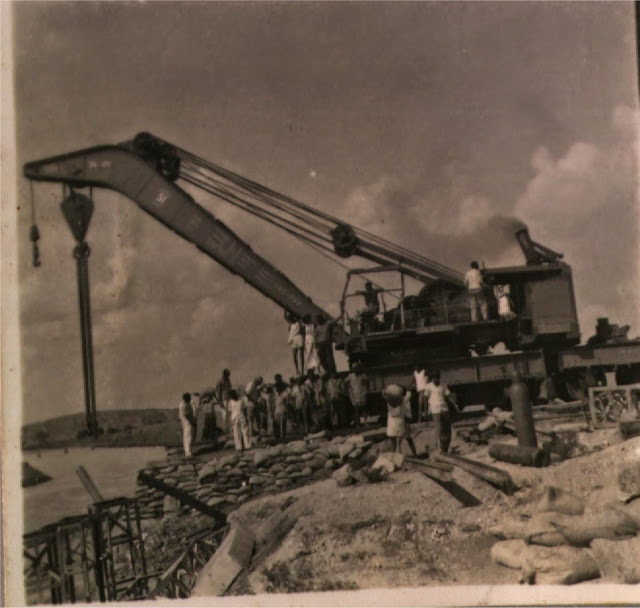It was sometime in early sixties and we were then living in a place called Hospet in Karnataka. I was too young to remember much but was maybe 5 years old at best. My father was working on a project near a place called Kariganur near Hospet which was for a railway line to carry Iron Ore from the mines in Bellary. The line traveled all the way to Hospet and it had to cross what was known as the Tungabhadra power canal which was very close to our house. The railway lines had been laid upto either end of the canal but the canal itself did not have a railway line. The girder was however in place as can be seen below.
Now for those who dont know Railways there is a practice called loose shunting which I am unsure is practiced today. What they did was that when they were to shift the coaches, wagons between lines the engine driver sometimes decoupled the lot the moment they are on the right line. These bogies then continued moving due to their initial momentum and stop by themselves after a distance. This helps the engine move on to the next task and avoid losing time.
Now one fine morning at a place called Kariganur, near Hospet a engine driver did precisely that with a bunch of wagons having iron ore. Unfortunately for him he was still on the main line and not a loop line. This main line had been connected to the new line under construction. Also the line from Kariganur to Hospet had a downwards slope. So as anyone can guess these bunch of wagons started rolling downwards, given the weight they carried, they picked up speed and momentum and then started hurtling down at top speed.
My mother who happened to be standing at the rear of the house was horrified to see a train without a engine hurtling at top speed and screamed even as the wagons smashed against the girder laid across the Tungabhadra power canal.
What was amazing was that a number of wagons crossed this girder without lines and miraculously landed on the lines on the other side and continued travelling for a short distance before derailing and falling. When you see the picture above and the others below you can get a idea of the speed and velocity of the iron ore filled train that literally jumped onto a girder with no rails, smashed it to pulp, then travelled through it, jumped on to the tracks on the other side and still travelled a distance before finally collapsing even as one continued to stay on the track like a winner.
The canal had water flowing at high speed and if I remember right was connected to the power station upstream which meant that one had to work without stopping the water. I think they did reduce the water flow and such since it was impossible for people to work but all in all my father had a royal mess on his hands.
 |
| Mangled wagons with iron ore |
 |
| The girder was crumpled like a piece of paper |
 |
| The line on the other side over which the wagons travelled |
 |
| As a child I found it fascinating to see the crane lift the heavy stuff and this was right behind where we lived |
 |
| Once the water flow had been reduced people could get near the site to work |
 |
| A miracle that a few wagons stayed upright |
 |
| Workers clearing the mess |
 |
| Getting the girder I remember was supposed to be a task since they had to build a new line to carry the crane to the accident spot |
 |
| Another view |
 |
| A birds eye view. Still unsure how my father took this picture given the height unless he stood on the crane itself - knowing him, perfectly possible |
 |
| A close up |
 |
| Soon after the accident. See the swirling waters |
 |
| Not just workmen even children found it fascinating |
 |
| The mangled wagons |
 |
| These are wagons that derailed further down |
 |
| Workmen cutting open the lines |
 |
| A shot taken in the night which shows the foaming waters |
 |
| Cranes lifting the mangled remains |
 |
| What had been constructed, now destroyed being cleared by the same workmen |
 |
| Some of the wagons that had actually continued on the tracks AFTER the trackless girder |
 |
| Once the water level receded |
The next part of this series of blogs is here




Comments